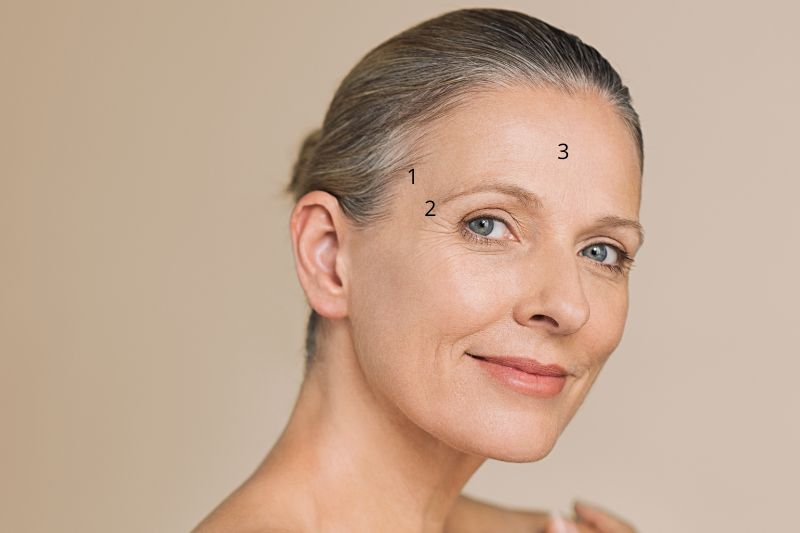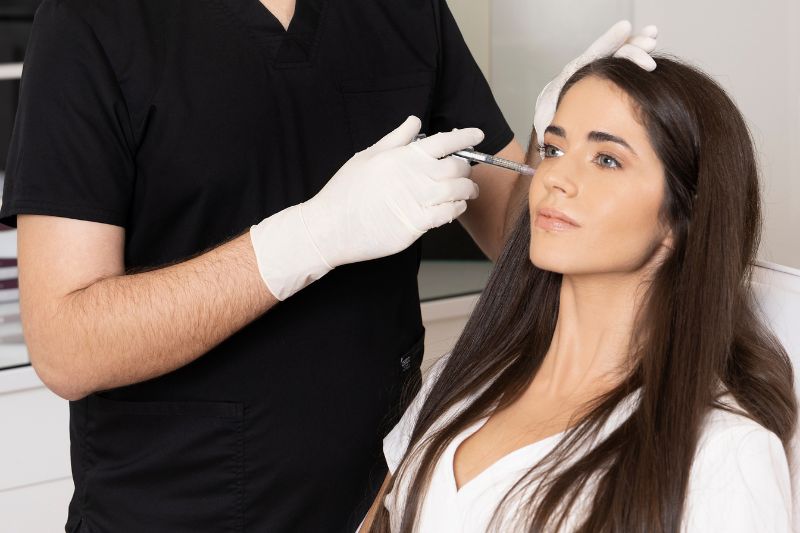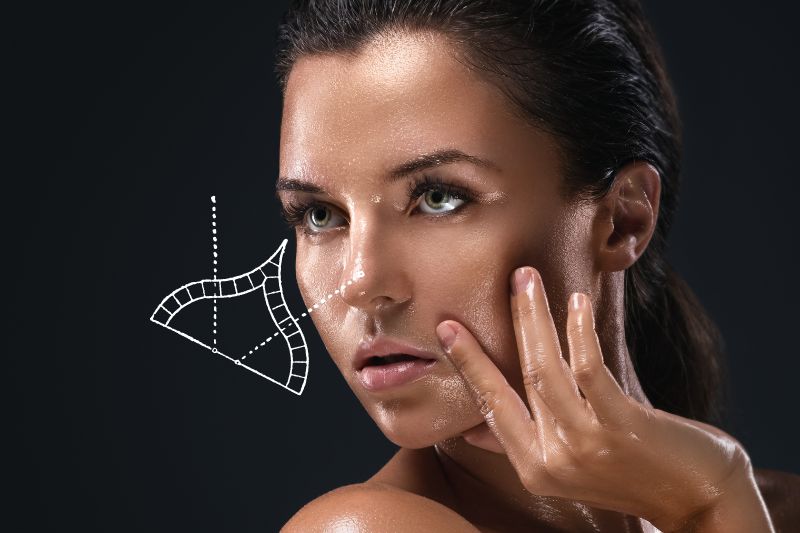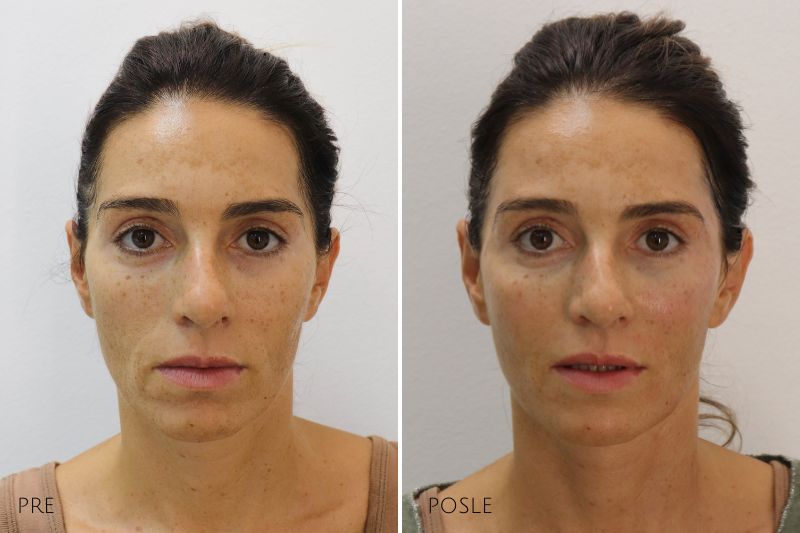The upper third of the face consists of the forehead, temples, eyebrows, the area between the eyebrows known as the glabella, and the upper eyelids. Over time, this facial area is susceptible to the effects of aging and external factors, leading to the development of hyperpigmentation, wrinkles, hollows, and loose skin. As a result, the face may appear older and thinner.
To restore a youthful appearance to the upper part of the face, we offer a range of treatments including Botox, hyaluronic fillers, chemical peels, and skin boosters. These procedures are designed to address various concerns such as replenishing lost volume, reducing wrinkles, lifting the eyebrows, improving skin quality, and slowing down the aging process.
.
Forehead and temples- restoring youthful contours
The forehead is one of the initial facial areas where signs of aging become apparent, particularly through the development of fine lines. The contraction of the forehead muscle (frontalis) leads to the formation of horizontal wrinkles in the central and upper areas, as well as vertical wrinkles between the eyebrows, known as frown lines. Botox is an effective treatment for eliminating these wrinkles, and regular use of Botox can help delay the formation of new wrinkles.
Another indication of aging in the forehead is the loss of subcutaneous fat and bone tissue resorption. This process results in the formation of indentations, furrows, and ultimately changes in the shape of the forehead. In youthful individuals, the frontal bone tends to have a slightly protruding, convex shape in women. However, as one ages, the forehead flattens and the central part of the frontal bone may even slightly deepen. Hyaluronic fillers can address these hollow areas and irregularities with a smaller amount of filler. This helps restore a rounded shape to the forehead, ultimately contributing to a more youthful overall facial appearance. To better illustrate this, please refer to the image below.

Signs of aging of the upper third of the face: 1. Lack of volume in the temporal area. 2. A low eyebrow. 3. Lack of volume and concave shape of the forehead.
forehead and temples augmentation
Forehead and temples augmentation using filler restores contour, adds volume, and softens wrinkles.
What is the amount of filler needed for augmentation?
On average, 1 milliliter of filler is needed, while in case of greater loss of subcutaneous tissue, up to 2 milliliters.
What does treatment look like?
The procedure starts by cleansing the face and applying an anesthetic cream to ensure the patient’s complete comfort during the treatment. It is then followed by the precise injection of hyaluronic acid filler.

What changes in the temples do occur with aging?
Aging in the temporal area involves several changes such as loss of fat tissue volume, resorption of bone tissue, muscle atrophy, and skin laxity. These factors contribute to a sunken appearance in the temples. Furthermore, the loss of tissue in the upper eyelids further accentuates the sunken look, resulting in a “skeletonized” appearance of the entire area.
Why is it important to fill temples?
When observing individuals who have received hyaluronic acid filler treatments, it is often evident that while the middle and lower parts of the face show significant rejuvenation, the temporal area is frequently overlooked. This neglect can result in visible signs of aging and an unnatural appearance. Moreover, when correcting the central area of the face, particularly the cheekbones, the lack of fullness in the temples becomes more pronounced.
Ideally, addressing the midface should be accompanied by filling the temporal area to achieve a natural arch in the cheekbones, commonly referred to as the beauty line or Ogee line. It is recommended to always consider the temporal area together with shaping the cheekbones to ensure a seamless and natural transition between these two facial areas.
What is an Ogee line and why is it important?
The Double S-curve line, also known as the Ogee curve, refers to the natural and aesthetically pleasing shape of the midface contours when viewed from a side profile. This line follows a distinctive S-shaped pattern, starting from the outer part of the eyebrow and temples, then continuing to the point where the upper and lower eyelids meet. From there, it extends to the cheekbones, forming the second part of the curved line.
The Ogee line is closely associated with a youthful appearance, as the face tends to lose its contours as it ages due to a decrease in volume and the effects of sagging skin.

Treating temples with fillers – results
By filling the temporal area with hyaluronic fillers, we not only restore volume and natural contours, but also achieve a lifting effect on the eyebrows, resulting in a more youthful appearance of the eye area. When there is a loss of volume in the upper eyelids, causing a hollow or sunken look, a small amount of filler can effectively correct this and rejuvenate the eyes. Additionally, filling the temples creates a seamless transition between the temples and cheekbones, gently raising the eyebrows and rejuvenating the eye area.
To visualize the results, we have an example of a patient who underwent temple area filling as part of a comprehensive facial rejuvenation treatment. You can learn more about her specific treatment and see the results by clicking here.

What does cause hollow eyes?
Aging leads to a decrease in the fat pad of the upper eyelid, which, along with bone changes, gives the appearance of sunken eyes. The problem can be solved by adding the volume with hyaluronic fillers with special caution, since it is an advanced and demanding technique.
How much filler is needed for temples?
On average, a total of 2ml of filler is most often used for the correction of both temples.
Price and additional questions
You can check the prices on the Pricelist page. If you have additional questions or want to book an appointment, please call us at 060/345-0304 or write at estetikabgd@gmail.com.
About the treatment:
